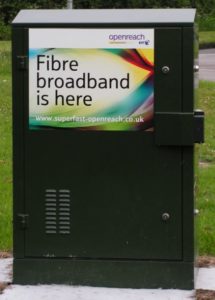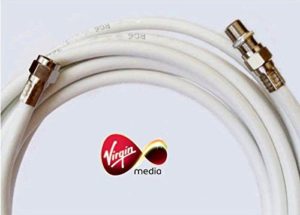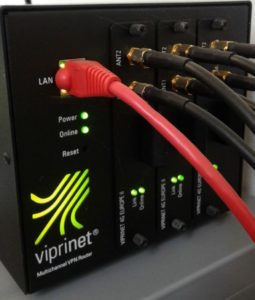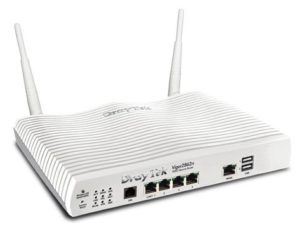What is the best Internet connection in Oxford, Abingdon, Bicester, Kidlington, etc., etc.? As is often the case, the answer is “it depends”. Although we provide IT Support services mostly in Oxfordshire, the vast majority of information in this article applies to the whole of the UK.
When it comes to broadband, not everything depends on your choice. A lot gets decided on where your home or business is located. And I’m not talking about a town or county here. The best option for you may be completely different from another business 0.5 miles away, even if the requirements are exactly the same.
So, what options do you have? Let’s look at types of broadband first.
ADSL and VDSL (FTTC) broadband

In short, this is an Internet connection over BT telephone lines.
ADSL is an older technology delivering quite low speeds, but still useful in remote areas, or if you are unlucky enough to live on a street where Virgin Media or FFTC network doesn’t quite reach.
VDSL or FFTC (Fibre To The Cabinet) is a much more practical choice for many businesses and individuals. It can achieve quite respectable 80Mbps download and 20Mbps upload speeds (in the best-case scenario). You have plenty of Internet Service Providers (ISPs) to choose from (even though they all use the same BT’s physical infrastructure). BT markets its FTTC broadband as BT Infinity. Many other ISPs call it some kind of “fibre” service. This is slightly misleading as fibre (optical cable) is only used to deliver the broadband to a green BT street cabinet that is not far away from your property, but the remaining distance is covered by the good old copper telephone cable.
To find out whether you can get FTTC service and if so roughly what speed you can expect, head to https://www.bt.com/broadband/availability and enter your address and (optionally) landline telephone number. Most FTTC providers have their own availability checkers, but you can expect very similar results from all of them. If FTTC is available, this is a solid and cost-effective choice for most households and businesses.
Cable broadband

For pretty much everyone in Oxfordshire (and most of the UK for that matter) choosing cable broadband means choosing Virgin Media. Virgin Media’s physical coverage is not as good as BT’s so first of all head to https://www.virginmedia.com/shop/broadband/compare and enter your address to check what you can get. If you live/work in an area covered by Virgin Media cable network, you almost certainly can get broadband that is faster than FTTC (at least the download part). But don’t jump to it straight away – there are a few things to consider.
First of all, although Virgin Media is quite generous with download speeds, this is not the case with the upload. For example, their cheapest 50Mbps and 100Mbps residential plans only offer 3Mbps and 6Mbps upload, and I wouldn’t recommend this to anyone. Faster packages come with more reasonable 20Mbps and 25Mbps upload speeds.
In my experience, Virgin Media speeds suffer much more from congestion during peak times than most good FFTC providers. So these excellent headline speeds can get quite a bit slower when you need them the most. I wouldn’t say complete outages are much more likely than with FTTC providers, but unexplained packet loss and short-term disconnections seem to affect Virgin Media quite regularly. Most residential customers don’t even notice such issues, but if you run VoIP or other business services sensitive to broadband quality, this needs to be considered. The last bit of bad news is that Virgin Media customer and technical support often leaves a lot to be desired.
In conclusion, Virgin Media is not a bad choice, especially if you need fast download speeds and can’t stretch to a leased line. However, if you value reliability and good customer support more than headline download speeds don’t discount FTTC. Or you can always go for “best of both worlds” and run both, Virgin and FTTC via a business firewall that can manage multiple Internet connections.
Leased line

This is the real “fibre” broadband where you have a dedicated optical line coming to your premises. Moreover, you have a guaranteed speed, which is the same for both, download and upload (also called a “symmetrical” connection). The speed is guaranteed and not affected by peak times because you don’t share the broadband with other ISP customers in the same area (which is the case with other types of Internet connectivity). There is only one bit of bad news here – the price. Installation costs can vary from free (with a looooong contract) to tens/hundreds of thousands of pounds (if road digging is involved). The monthly fee is generally a few hundred pounds or more depending on the speed you require (you can go from around 50Mbps up to 1Gbps or even more). Very few households would need or choose a leased line, it’s almost always used in business environments.
There are only a few companies that own large fibre networks, but they lease these networks to other providers, so you have many choices. Don’t hesitate to get a few quotes and negotiate as prices can vary significantly. Providers are often quite happy to squash their margins to get a long-term leased line customer.
Satellite and 4G broadband

Although technologically very different, I put these two together as they are often “the last resort” option in places where other broadband types and unavailable or too costly to install.
Satellite is available everywhere where you can see the sky, but it suffers from high latency. This is less of a problem with 4G, so if you have at least some 4G reception in most cases it’s a better choice than satellite.
If you want some extra speed and reliability, there are specialised ISPs that can bond multiple 4G connections (often from different 4G networks) into one fast and stable Internet line, and even provide one or multiple static public IP addresses which generally are not available on 4G connections.
So which one is the best?
First of all, you have to define what “the best” means to you – is it the fastest? Is it the cheapest? Is it the most reliable? For most people, it’s probably a combination of all three with some emphasis on one or two.
The best “money is no object” broadband without a doubt is a leased line. I have personally used Exponential-e and Southern Communications and could recommend both. I have also dealt with Virgin Media (yes, they do leased lines as well) and although the connection was fast and reliable, their customer and technical support was neither.
FTTC is often the most practical choice for most businesses and individuals (assuming you can get a decent speed). My provider of choice for many years has been ZEN Internet. Although you are likely to get similar speeds with other FTTC providers, ZEN’s UK-based customer and especially technical support are second to none. I have been dealing with them for over ten years, and they never let me down. ZEN are understandably not the cheapest, so if the cost is your primary concern, I would look at BT or PlusNet, depending on who offers a better deal at that particular time.
If you decide to go with cable broadband, you have only one choice – Virgin Media. Their customer and technical support are not terrible, but have loads of room for improvement, especially when compared with the likes of ZEN Internet. And if you value reliability, consider backing it up with some sort of FTTC or even a 4G connection.
Other considerations
Equipment

If you go ahead with FTTC, most IPS will provide some sort of router/firewall as part of the package.
For most households and some businesses, this is all they will ever need. If you need more control and features, you can easily replace this router with your own. For small businesses and home workers, I often use Draytek Vigor routers. For larger offices that require a more robust firewall, I tend to use SonicWALL. Just be aware that in this case, you will need a separate VDSL.

If you choose Virgin Media cable broadband, you are stuck with one of their hubs. But not all is lost if you want to use your own router/firewall. Most Virgin Media hubs can be put in a “modem mode” where NAT, firewall and most of their other features are disabled, allowing you to fully utilise another router. There are some complications with business Virgin Media Hubs (made by Hitron) when your Internet connection comes with a static public IP address. Due to how Virgin implements static IP addresses, these hubs can’t be put into proper modem mode. Virgin Media technical support can provide certain workarounds (which, if I remember correctly, may involve having to order more static IP addresses!). In short, if you are ordering a business Virgin Media connection with a static IP address(es) and intend to use your own router, check with Virgin Media technical support first.
Static IP addresses
Most FTTC providers offer static public v4 IP addresses to business customers either as part of a deal at a small additional charge.
If you are a consumer and require a static IP, I only know two major providers that offer them on non-business contracts – ZEN Internet and Plusnet. ZEN give away static IPs for free, and Plusnet charges a reasonable £5 one-off fee.
Virgin Media don’t offer true static IP addresses to consumers, but in practice, their public IPs change very rarely, which may be sufficient. Virgin Media Business customers can order static IPs with no issues, but as explained above, check with their support if you intend to use your own router.
Still not sure what broadband is the best for you? Even more confused than you were at the beginning? Get in touch!